How Much Does it Cost to Make an App in 2024?

Key takeaways
- Get insightful statistics on the mobile app market growth to understand the potential for your product’s profit.
- Learn what factors can affect your app development cost and what aspects should be considered when planning the allocation of your resources.
- Explore the hidden factors that affect the cost of building an app so they won’t come as a surprise to you during the development.
- Want to reduce your mobile app cost? Check out our list of useful tips on saving money without compromising product quality.
- Get a brief guide to the mobile app development process that also covers even more cost-cutting options.
- Can your app generate high revenue in such a competitive market? Check out the overview of real-life, successful apps and how they ended up being a highly profitable investment.
- Get useful information on monetizing your mobile app and an overview of the most popular business models.
Every app, whether it’s a well-established giant such as Tinder, Uber, Instagram, or a young startup, starts with an idea. But once a bright idea comes up in the mind of an entrepreneur, there is the question of how to bring it to life. However, this question becomes even more difficult if you have a strict budget. Understanding how to reduce the app making cost and how to stay within your limits is crucial.
After all, it would help if you did not rush to start a project and weigh all factors that affect the cost first. We are ready to help you by providing useful tips on how to reduce development costs and avoid hidden ones, and we will assist you with getting an in-depth understanding of what your resources will be spent on and at what stages.
Exploring average cost estimates for mobile app development
Grasping all the nuances related to the cost of mobile apps development holds paramount importance for businesses before the start of product implementation. It allows for resource optimization, ensuring their apps’ timely and successful release. The costs associated with app development vary widely depending on the product’s complexity, functionality, platform selection, and other factors that we’ll explore in detail.
Considering all the stages of development and factors that affect the cost of applications, the average cost to develop an app is $40,000 to $300,000 and, in certain cases, even more, according to the study conducted by GoodFirms. Such numbers most often refer to application development of medium to high complexity. In turn, according to Upwork, simple apps with limited features might cost between $10,000 and $50,000.
Although mobile app development can require significant investment of resources and time, developing your own product is more relevant than ever before, considering that the market is on the rise. Let’s ensure it by looking at the statistics below.
A brief overview of the mobile app market
- There are currently over 5 billion smartphone users worldwide, and that number is expected to grow by 10% between 2024 and 2028.
- The number of mobile apps downloaded worldwide has been rising quickly, and by 2025, it is predicted to bring in over $613 billion, which is a compelling argument for investing in mobile app development.
- In 2022, the USA app market brought in $42.2 billion in revenue.
- In 2022, mobile apps accounted for almost 4 trillion hours of usage worldwide.
- Users spend 88% of their time in apps.
- Companies that create mobile solutions are expected to get 26% of all funding worldwide in 2020, according to Crunchbase.
- Businesses engaging customers through mobile apps witness a 36% higher retention rate than those relying solely on traditional channels.
We have looked at the approximate applications costs and the dynamically evolving state of the mobile app market. Now, let’s examine in detail what factors influence the cost of app development.
Calculating your app’s cost: delve into these six key factors
Building a mobile app is a complex journey that requires careful planning, skilled execution, and consideration of various factors. Let’s look at five key elements that affect the development cost and explore the intricacies of app creation cost. Let’s figure out together, how much does it cost to make an app?
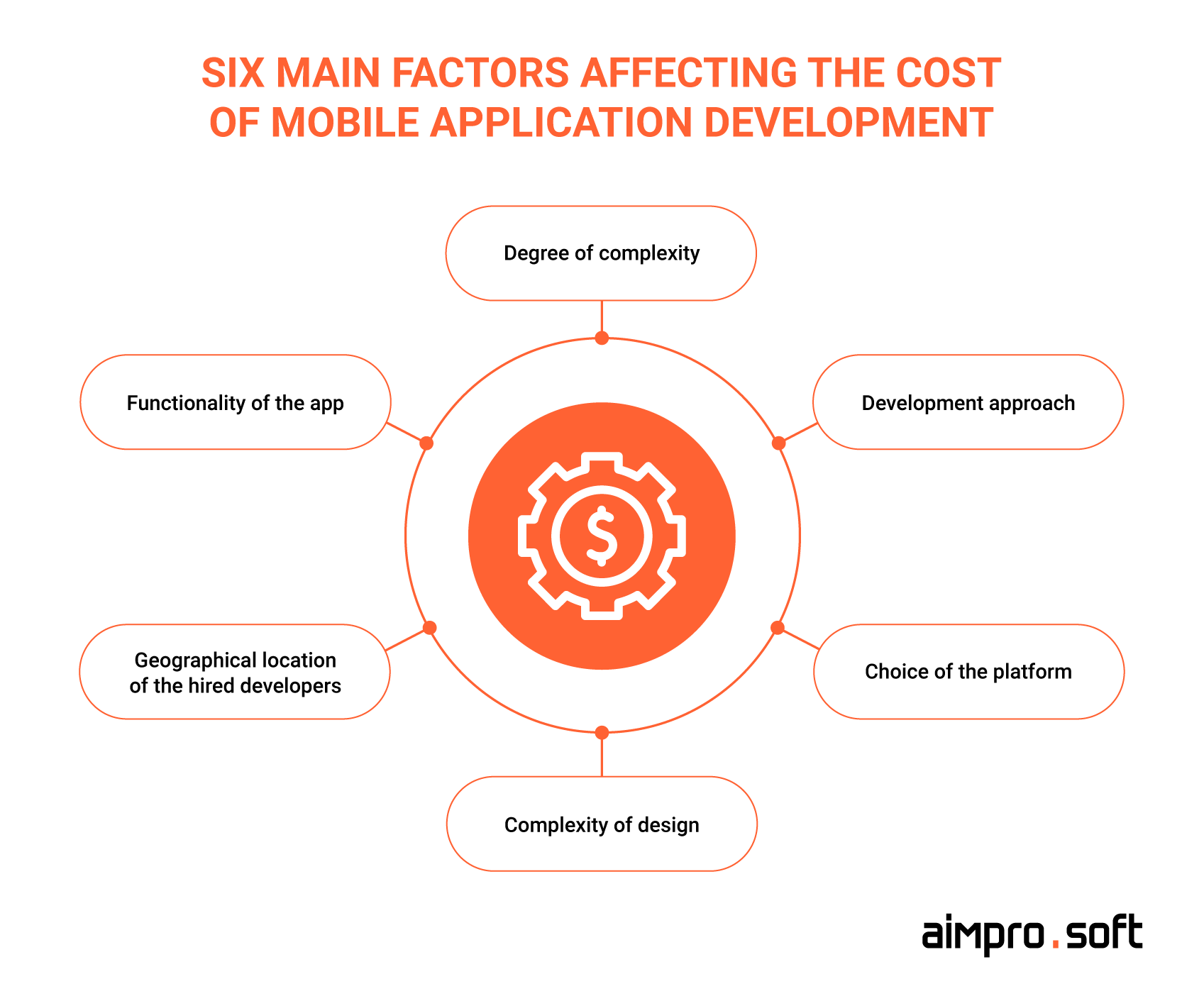
Six major factors affecting the price of a mobile app
Assessing the degree of app development complexity
The complexity of an application has a significant impact on its development cost. For example, the development of complex mobile apps is associated with increased costs due to intricate design, advanced features, and emerging technologies such as AI or AR. The labor-intensive nature of complex app development leads to prolonged project timelines, which affects the cost to create an app. These aspects are the reason for increased financial investment in developing such applications.
| App complexity | Approximate cost range | Examples of features affecting app’s complexity |
|---|---|---|
| Simple apps | $5,000 — $40,000 | Static content, simple navigation, limited user interactions, limited data processing, single-user support |
| Moderate complexity | $50,000 — $100,000 | Advanced search capabilities, social media integration, multi-user support with basic collaboration features |
| Complex apps | $100,000 — $250,000+ | Real-time communication, machine learning integration, augmented reality (AR), complex security measures, cutting-edge features like AI, or IoT, advanced security protocols, and complex data processing |
This table of costs is approximate and is based on the survey conducted by credible platforms like BusinessofApps, Upwork, and GoodFirms, which we mentioned above, and Aimprosoft expertise in mobile application development. However, to estimate the exact cost required for your app development, you need to conduct market research on the app developer prices and discovery phase first to get a detailed time and cost estimation of each SDLC phase.
An application’s complexity is usually determined in the early stages of development planning. This assessment helps to understand the requirements and budget of the project. The complexity of the application can be assessed by such experts:
- Software architects: They assess the complexity of the application architecture and the technical challenges associated with it. Technical architects are needed during complex projects’ initial planning and architecture development phases. For simple applications, the engagement of such a specialist may be optional.
- UI/UX designers: They assess the complexity of the application’s user interface and user experience requirements. A UI/UX designer is needed in the design phase that follows conceptualization. They are involved in creating an attractive interface and user-friendly navigation.
- Business analysts: They assess complexity from a business perspective, considering market requirements and user expectations. The involvement of a business analyst is critical at the project initiation stage to understand business goals and objectives while working closely with customers and stakeholders. A dedicated BA may not be necessary when the customer provides a detailed and comprehensive set of requirements or when the requirements are simple and well-defined.
Indicative costs of core functions
Careful selection of features to be included in an app is of utmost importance as it directly affects the app’s success, user satisfaction, and overall development cost. For example, in an e-commerce app, the main features should be a product list, a shopping cart, and secure payment methods that provide a convenient shopping experience. In contrast, a social networking application should focus on user profiles, posting capabilities, and interaction features such as comments and likes to increase user engagement.
In the case of a project management tool, features such as task assignment, document sharing, and progress tracking are essential to enhance collaboration and productivity. Defining functionality early in the development process ensures that the application meets user needs and the resources will be allocated efficiently. Such experts can help you with identifying the core features of your product:
Product managers: Product managers are responsible for defining the overall concept and development strategy of the application. They identify market needs, user requirements, and business goals. They work to prioritize features and ensure they align with product goals.
Business analysts: Business analysts collect and analyze data to understand user needs and industry trends. They help define the application’s scope, features, and functionality.
User experience (UX) designers: UX designers focus on creating a user-friendly interface and ensuring that features enhance the user experience. They work closely with product managers to translate requirements into user-centric features.
At what stages will you need a particular specialist from this list, and for what specific activities do you need them?
Product managers, business analysts, and stakeholders brainstorm and develop ideas to define an initial set of features. These processes typically occur during the planning phase. Business analysts and product managers define detailed requirements during the requirements analysis phase, refining features and functionality. UX designers get to start in the design phase, working on the design of features and ensuring that they meet the needs and expectations of users.
Development approach
When embarking cost to develop an app, a crucial decision is determining the most cost-effective employment model: in-house, freelance, outsourcing, or outstaffing. This choice hinges on budget considerations, requiring a thoughtful evaluation of the pros and cons associated with each model.
- In-house development
The in-house employment model involves recruiting and employing developers directly within the company rather than outsourcing. With this approach, developers become integral members of the organization, working closely with other departments and sharing a common work culture. Let’s consider the pros and cons of this hiring model below:
Pros:
1. Team integration
In-house developers are easily integrated into the company culture, fostering better interaction and communication among team members.
2. Focus
In-house developers are dedicated to company projects, ensuring constant attention and focus on internal goals.
Cons:
1. Costs
High costs are associated with maintaining an in-house team, including salaries, benefits, office space, and equipment.
2. Limited expertise
In-house teams may have limitations regarding diverse skill sets or expertise available in the broader market.
3. Scaling challenges
Scaling a team quickly can be difficult, especially during periods of rapid growth, as it takes time to screen, hire, and attract new talent.
Let’s take a look at the salaries of engineers developing mobile solutions by country:
| Country | Android developer salary per year | iOS developer salary per year | Cross-platform developer salary per year |
|---|---|---|---|
| USA | $135,000 — $150,000 | $120,600 — $135,700 | $115,000 — $125,600 |
| Latin America | $40,000 — $60,000 | $40,000 — $55,000 | $40,000 — $55,000 |
| United Kingdom | $75, 300 — $85,000 | $80,300 — $90,000 | $60,000 — $84,400 |
| Western Europe (e.g., Germany) | $73,400 — $80,000 | $60,000 — $77,000 | $54,000 — $62,000 |
| Eastern Europe (e.g., Ukraine) | $50,000 — $60,000 | $40,00 — $50,000 | $37,600 — $41,000 |
- Hiring freelancers
The freelance hiring model involves hiring independent professionals or freelancers to perform specific organizational tasks, projects, or roles. This approach provides flexibility, allowing companies to utilize a global talent pool for short-term assignments or expertise without hiring full-time employees.
Here’s the average hourly rate of freelance developers:
- iOS developer: hourly rate $45-75+
- Android developer: hourly rate $25-85+
- React Native developer (cross-platform): hourly rate $25-70+
Pros:
1. Flexibility
Freelancers allow companies to increase or decrease staffing levels depending on the project’s needs without the long-term commitment associated with full-time employment.
2. Cost-effective
Using freelancers can be cost-effective because companies pay for specific services without the overhead costs of maintaining full-time staff.
Cons:
1. Dependence on individual contributors
Projects can depend on the availability and reliability of individual freelancers, which creates risks if they are unavailable or canceled.
2. Quality and consistency
When working with different freelancers, it can be a challenge to ensure consistent quality, as standards can vary according to individual skills and practices.
- Outsourcing or outstaffing
Many companies are opting for outsourcing, and it’s an approach that’s not losing popularity. For example, according to a new analysis by Grand View Research Inc., the size of the worldwide outsourcing market is expected to reach $525.2 billion by 2030. Outsourcing can be very profitable due to the much lower costs in other regions. Businesses can optimize their budgets while maintaining quality and efficiency by using labor markets in countries with lower costs of living and competitive rates.
Pros:
1. Cost-effectiveness
Outsourcing often saves money because companies can leverage the lower labor costs of outsourcing partners in different regions.
2. Access to global talent
Companies gain access to a broader talent pool, including specialized skills that may not be available internally.
3. Focus on core competencies
Outsourcing non-core functions allows organizations to focus on their core competencies and strategic objectives.
4. Scalability
Outsourcing provides flexibility, allowing companies to scale up or down depending on project needs.
Cons
1. Communication problems
Working across time zones and cultures can lead to communication problems that negatively impact project coordination.
2. Security risks
Potential security and privacy risks are associated with sharing sensitive data with third-party vendors.
Let’s look at the developer’s hourly rate by country by examining some of the most popular destinations and how much does it cost to create an app:
| Country | Average hourly rates |
|---|---|
| USA | $90 ー $105 |
| Latin America | $50 ー $75 |
| United Kingdom | $80 ー $100 |
| Western Europe (e.g., Germany) | $70 ー $90 |
| Eastern Europe (e.g., Ukraine) | $45 ー $60 |
Geographic location’s impact on development costs
In case you go with outstaffing or outsourcing, one of the most cost-efficient options, the geographical location of the development company can heavily impact the development cost since rates vary from region to region. Various factors determine the significance of this decision:
- Cost differences by region
The geographical location of the development team has a significant impact on the cost structure. It depends on several key elements, including labor costs, the standard of living, and market dynamics. These variables determine how much do apps cost and how much you must spend to bring your app idea to life.
- Regional differences
In addition to broad geographic categorization, there are pronounced differences within regions. For example, North America, which includes the US and Canada, tends to have higher development costs than Latin America or Eastern Europe. Similarly, Western European countries such as the UK, Germany, and France tend to have higher rates than their Eastern European counterparts such as Ukraine or Poland.
When choosing an outsourcing region for mobile app development, finding a balance between cost and quality is essential, considering the value for money. For example, Ukraine is famous for its excellent development quality and competitive prices, which makes it an attractive choice.
Interested in choosing a software supplier from Ukraine? Read our article on the topic and get information about the pros of this location and its specialists.
Also, evaluate the qualifications and experience of developers and companies in your chosen region. Study their portfolios and customer reviews to evaluate their past works.
Legal and data security regulations should align with your requirements and industry standards. Research the region’s intellectual property protection laws and agreements to secure your application’s code and assets. Assess the availability of infrastructure and technology to ensure smooth development.
Platform selection for your app
The cost of mobile app development is very much influenced by factors such as the choice of platform. You can choose to build either an Android or iOS-based native app or make the application cross-platform and target two platforms at once. So the question is, what platform should you choose? Let’s look at these three options and how they affect the cost:
- Android
Developers with knowledge of languages such as Java or Kotlin are usually hired to deploy applications on such a platform. Android’s open-source infrastructure promotes flexibility, allowing complex designs and features to be implemented. In addition, releasing apps on Google Play is simpler and faster than on iOS. And despite the drawbacks of fragmentation, Android’s flexibility allows apps to be developed for various devices.
- iOS
iOS apps usually require experts with good Swift or Objective-C language skills. The platform’s stability, uniform iOS version across devices, and closed ecosystem contribute to quick, responsive, and user-friendly apps. Apple’s intuitive user interface, guided by a comprehensive design manual, ensures a great user experience and seamless software and hardware integration. But iOS supports a maximum of 20 distinct operating system versions and device types.
- Cross-platform
Developing apps simultaneously for iOS and Android is a favorable solution. Cross-platform has several advantages, such as using a single code and lesser development effort. Cross-platform development is well-suited for different types of applications and can benefit businesses with budget limitations and the ones that want to achieve faster time to market. For example, this approach is suitable for eCommerce, small-scale business apps, content-based and utility applications, etc.

Choosing a mobile app platform is a critical decision. It affects the app’s performance, functionality, design, user experience, costs, time, and resources. Here are some key aspects to consider when choosing a platform:
- Target audience: Understand your users’ demographics and preferences to choose the right platform and framework. For example, iOS is more popular in the US, while Android dominates globally. Android dominates in European countries such as Poland, Hungary, and the Czech Republic, as well as all countries in Latin America. In addition, Google’s Android dominates Asia’s mobile operating system market.
- App goals: The goals of your project also influence the choice of platform. For example, factors such as target audience demographics, revenue generation model, and market penetration strategy are influential. Decision-making aligns with overall business objectives, ensuring that the mobile app aligns with the company’s mission and vision.
- App performance and quality: Determine your requirements regarding the application’s speed, reliability, and security. Native frameworks use platform-specific capabilities, while cross-platform frameworks adapt to different environments.
- App maintenance and updates: Plan your update frequency. Cross-platform frameworks like Cordova allow rapid deployment, while native frameworks comply with platform guidelines.
- App scalability and growth: Anticipate future expansion. Cross-platform frameworks like Flutter support localization, while native frameworks offer access to platform-specific features.
Remember that the right choice depends on your business specific needs and goals. Evaluate these factors to make an informed decision.
So, we can help you analyze your project and advise you on the choice of platform and technologies for time and cost-efficient development.
CONTACT USComplexity of design
Design is the most crucial aspect of app development, significantly affecting the project’s overall cost. This process includes stages like market research, mockup creation, prototyping, animation, user testing, and much more. Each step requires specialized skills, time, and resources, which increase the cost of creating a visually appealing and user-friendly app.
Here are more aspects affecting the development price when creating an app design:
- Complexity or features
More complex designs and sophisticated features increase development time and effort, directly affecting cost.
- User Experience (UX)
A well-designed UX increases user satisfaction and usability but may require additional research of the market, competitors, and target audience, which affects cost.
- Number of screens and interactions
The more screens and complex interactions in an application, the higher the design and development cost.
- Customization and branding
Custom design and branding elements may require additional design work, which affects both time and cost.
- Prototyping and wireframe design
The creation of interactive prototypes to test the viability of the product idea requires investments, but it can prevent costly changes during development.
Below is an example table where we will look at the different types of work involved in creating a design for an app and their approximate cost:
| Activity | Description | Approximate Price |
|---|---|---|
| Market research | Conducting research to analyze the target market, competitors, and user needs. | $1,000 ー$5,000 |
| Wireframing | Designing basic layouts and structures of the application to visualize its functionality. | $1,000 ー $3,000 |
| Prototyping | Developing interactive prototypes to demonstrate the flow and functionality of the application. | $2,000 ー $8,000 |
| Design iterations | Making necessary adjustments to the design based on feedback and testing results. | $1,000 ー $4,000 |
So, we have covered the main factors that affect the cost of mobile app development, from the complexity of your product to the choice of business model. Now, let’s learn about those influencing factors that often go unnoticed, but you should also pay attention to them.
Hidden factors impacting the price of mobile app development
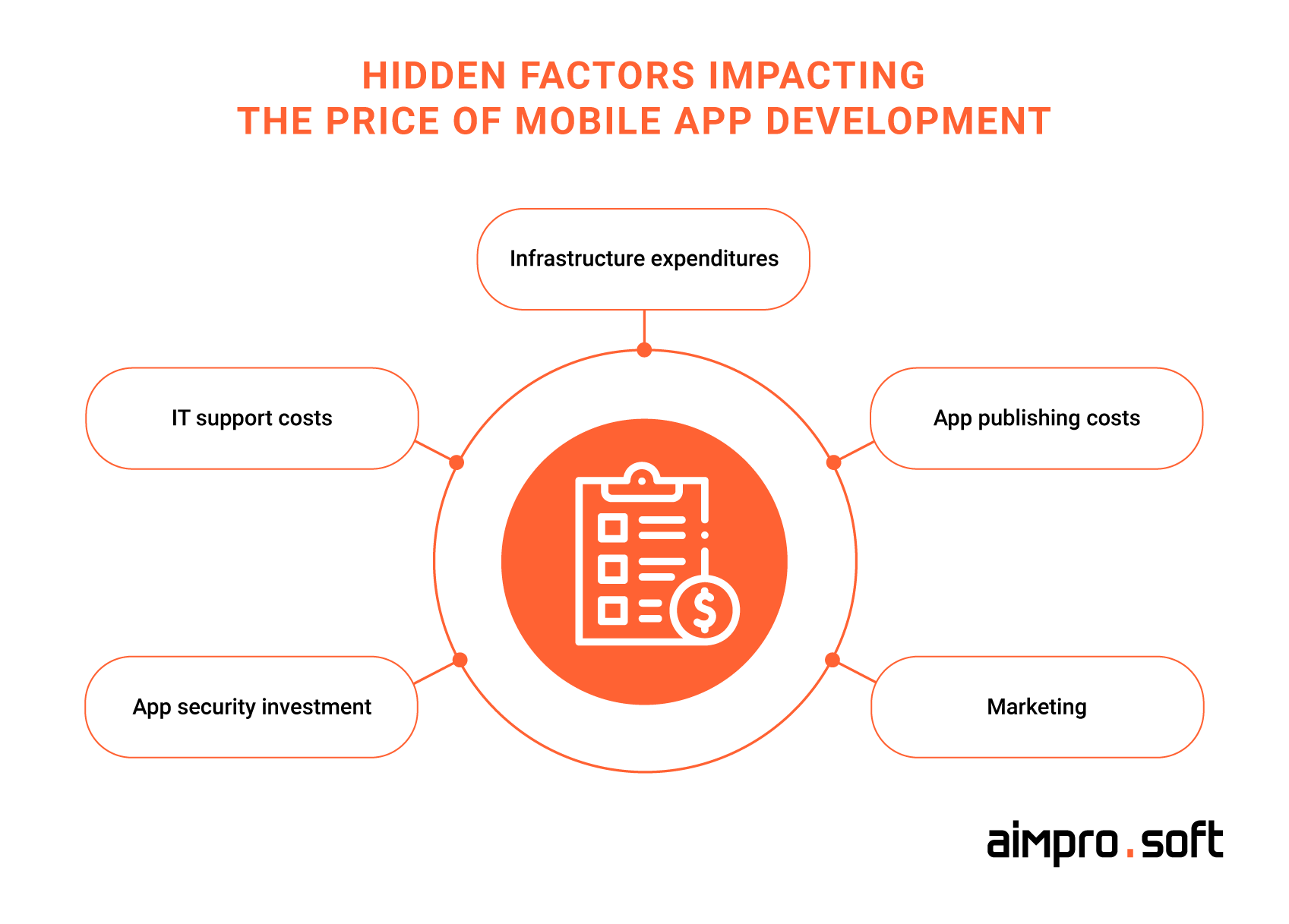
Hidden factors affecting the development price
Infrastructure expenditures
Infrastructure decisions made for a mobile application can significantly affect the overall cost of its development. One key factor is the choice of hosting and servers. Choosing cloud-based solutions such as AWS, Azure, or Google Cloud provides scalability but can come with ongoing usage costs. On the other hand, self-hosting requires an initial investment but offers more control. In addition, the complexity of the application’s backend architecture plays an important role. It includes databases, APIs, and server configuration. Applications with higher data processing requirements require higher development costs.
When making such decisions, it is essential to find a balance between scalability and cost control and consider the backend’s complexity.
IT support costs
Supporting a mobile app throughout its lifecycle significantly impacts the overall development cost. For example, mobile applications require constant attention to ensure their correct operation. This includes bug fixes, feature enhancements, and adapting to new versions of operating systems (OS). It also includes providing adequate user support, which includes solving user problems and considering their opinions. Remember about mobile app security; regular security updates and patches are necessary to protect user data and maintain the app’s integrity. Allocating a sufficient budget for security measures requires an investment.
App publishing costs
Google Play requires developers to pay a one-time $25 registration fee. In contrast, Apple charges an annual developer fee of $99, payable annually for those who want to make their app available on the AppleStore. These initial fees are standard practice in the app development industry. Google Play’s one-time fee is cost-effective for companies that don’t require frequent updates and support. On the other hand, Apple’s annual fee includes a broader range of services and benefits, including access to Apple’s development tools.
App security investment
When developing mCommerce, messengers, banking apps, enterprise mobile apps, or any others that presuppose the exchange and storage of sensitive user data, security is paramount. Integrating robust security measures is essential, considering the mobile app development cost. These measures safeguard sensitive information, such as employee credentials, customer data, and payment details. Security measures may include multi-factor authentication and cryptographic technologies, incurring data validation and threat model development costs.
Inadequate security can lead to substantial financial losses, with an average data breach cost of $4.54 million. Mobile app security testing, like penetration testing, can also be expensive, with a single test costing $20,000 to $30,000.
Marketing
In mobile app development, marketing is a hidden but integral factor that significantly affects the final cost of the app. Effective promotion of an app is the key to its success in a highly competitive market. Marketing research, advertising, user engagement, and ongoing promotion are integral components of a comprehensive marketing strategy, each of which entails certain costs.
Considering these costs in advance is paramount, as the mobile app market is oversaturated with many offerings. Even if an app has innovative features and functions, its success depends on user recognition and awareness. Mobile marketing drives brand awareness, contributing to a 60% increase in smartphone customers engaging with brands. If marketing costs are not considered, an innovative product may go unnoticed and overshadow competitors with active marketing campaigns.
We have looked at the many factors of how much does it cost to develop an app, and it may seem like a lot. You may even think that it can take unbearable investments to build an app from scratch. But to prevent this, the experts at Aimprosoft share with you practices that will help reduce app development costs and prevent you from going over budget. Let’s take a look at these practices below.
How to cut down on mobile app development expenses
You have decided to start developing a mobile application but faced certain budget constraints. In that case, you should not despair but look for solutions that will allow you to reduce the development cost without compromising the final product’s quality. And we can tell you that it is possible. Despite budget limitations, there are effective strategies to overcome financial limitations in application development. That’s why we have prepared for you some useful practices that can help you reduce costs and prevent you from going over the budget limit.
Preparation of detailed documentation
There are many things to consider when developing a mobile app; there is a step that will help you prevent going over budget and spending extra money. And that’s the discovery stage. Without this stage, it is impossible to plan the product development, set product goals, and even approve features in your app.
As one of our technical team leads says: “To reduce the budget, the client and developers must be on the same page. Developers need to understand exactly what is in the client’s head and what kind of product they want to get. For this purpose, we offer a discovery phase to “convert” the client’s thoughts into a document the developers will work with to justify all the client’s goals.”
With clear project documentation, you can be more confident in the success of your product not only after its release but even during the development cycle because you and the developers will be on the same page. The developer will not have to rewrite the code, add new features, or remove them, and all this will significantly reduce the time and cost of creating an app and, therefore, the budget.
Want to learn more about the discovery stage and how this stage is beneficial? Find out more in our article.
Early involvement of quality assurance
Identifying and fixing defects early in development is more cost-effective than fixing them later. Early QA involvement helps identify problems at a stage where fixing them takes less time and money compared to updates and post-release support. Early QA involvement ensures thorough testing of the application. This reduces the likelihood that critical issues will not be fixed, contributing to a more stable and reliable product. To summarise, early identification and resolution of issues saves time in the overall development lifecycle.
Creating an MVP
An MVP, or minimum viable product, is an initial version of a product that includes only the basic features needed to meet the basic needs of the first users. Startups and other companies create MVPs to get feedback from users and gather information to understand their needs and preferences. Also, creating an MVP helps to confirm market demand before investing heavily. MVP development focuses on critical features to avoid wasting resources on unnecessary components. The iterative nature of MVP development allows for incremental adjustments, reducing the risk of unforeseen costs and ensuring efficient use of resources.
Choosing outsourcing
Outsourcing software development offers significant cost advantages over hiring an in-house development team. Outsourcing to regions with lower labor costs allows companies to access skilled professionals at a fraction of the cost of hiring in-house developers in high-wage areas. Also, outsourcing eliminates the need for additional infrastructure and office space, reducing overhead costs. Using this approach, you can increase or decrease the size of your development team depending on the project’s needs, providing flexibility without the long-term commitment associated with hiring in-house staff.
In short, outsourcing software development is a cost-effective strategy that reduces costs, provides access to a global talent pool, and promotes flexibility.
Exploring cross-platform development
Above, we have already discussed how choosing a cross-platform approach reduces the cost of mobile app development; let’s now look at what makes choosing cross-platform an advantageous decision. Cross-platform development allows developers to write code that can be used on multiple platforms, reducing the need for separate development for each platform.
With shared code bases and reusable components, developers can speed up the development process, resulting in a shorter time to market for the application. This is very important in a dynamic and competitive application development environment. Cross-platform development allows applications to be deployed on multiple platforms simultaneously, reaching a wider audience, which helps to increase future revenue.
Key steps of the mobile app development process
Above, we have already talked about such vital stages of mobile app development as creating an MVP, choosing a platform, and deciding on a partnership model. But now, let’s look at the preliminary stages of mobile app development and the most basic steps in the development cycle. It’s worth noting that the steps can be fewer or more, depending on the needs of your unique project.
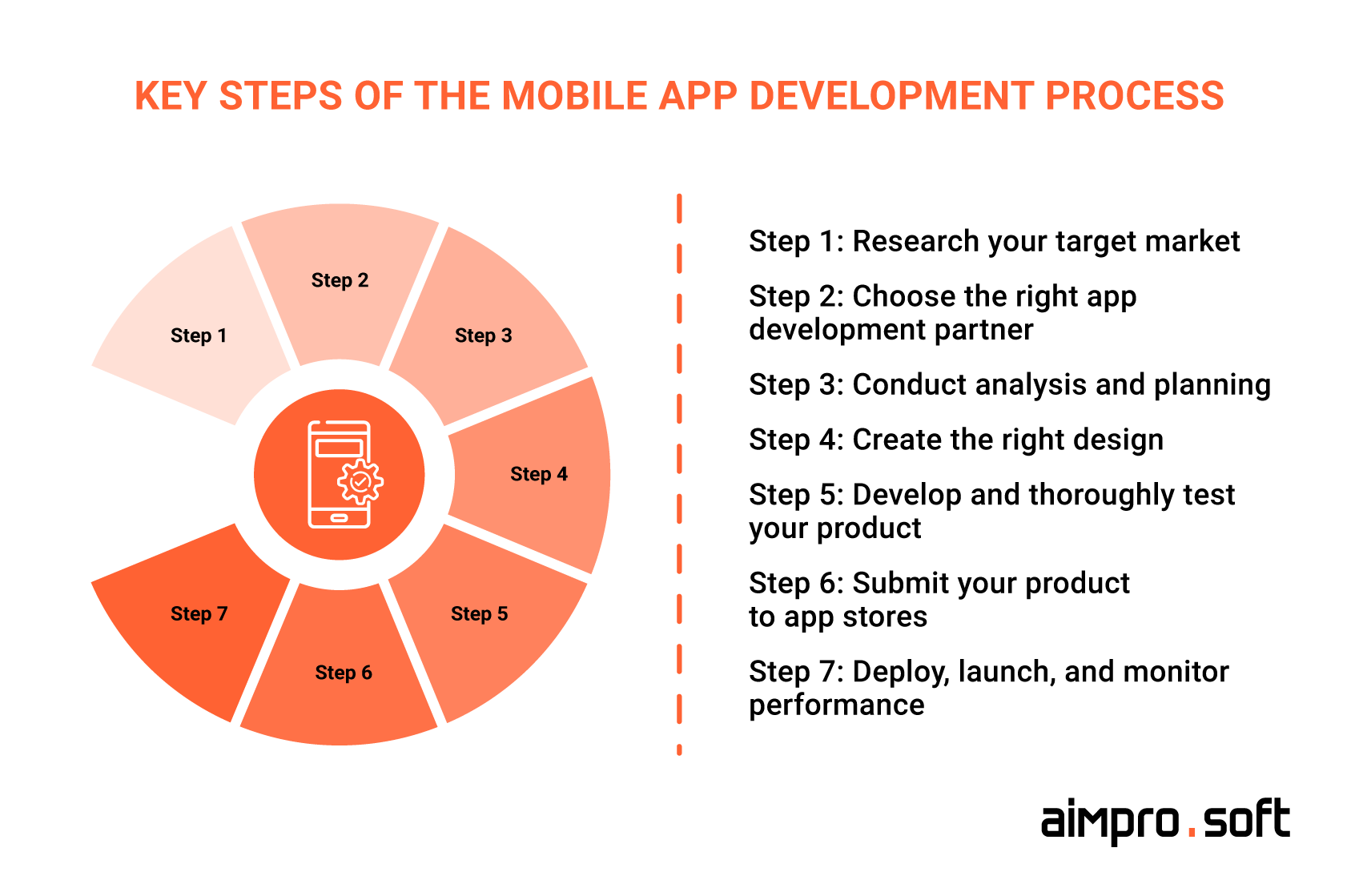
Key stages for developing a mobile application
Step 1: Research your target market
Investing in market research ensures that the app is not only technically perfect but also meets the specific needs and preferences of the target audience. This stage involves a comprehensive study of your business vision and goals. Special attention is paid to the target market study, allowing the development team to understand the project’s requirements, technical capabilities, and limitations. This stage sets the stage for the subsequent phases, including design, development, testing, and implementation.
Step 2: Choose the right app development partner
Choosing the right application development partner is a decision that will largely determine the success of your project. Selecting an unreliable software vendor carries the risk of missing deadlines, jeopardizing project timelines, and impacting business objectives. Poor communication and security issues further exacerbate these risks, leading to misunderstandings, data breaches, and damage to your company’s reputation.
So, how do you prevent this from ever happening? Look for a development partner with solid experience in your industry or niche. Examine the development partner’s portfolio and evaluate their previous projects. Looking for customer testimonials gives you an idea of the development team’s capabilities and how satisfied previous clients were with their work. Make sure they have a successful history of building apps similar to yours. You can research reliable sources like TechBehemoths, Clutch, or GoodFirms to ensure the supplier has a good reputation.
Step 3: Conduct analysis and planning
In the critical stages of the mobile app development process, the analysis and planning phase is key to ensuring the project’s success. This phase’s two most important components are the business analysis and the discovery phase. Business analysis involves a detailed examination of the client’s needs, market trends, and potential problems, which lays the foundation for an informed development strategy. The Discovery stage further develops the process by removing uncertainties and laying a solid foundation for follow-up.
Identifying potential pitfalls early on can minimize errors during development, saving time and resources. Careful analysis and planning build trust and communication among stakeholders and contribute to the overall efficiency and success of the mobile app development process.
Step 4: Create the right design
Design creation is a fundamental aspect of user engagement and satisfaction. Creating an effective design is important in terms of aesthetic appeal and ensuring a seamless user experience. It involves understanding the target audience, defining clear objectives, and conducting market research to align the design with user preferences.
Prototyping at this stage is essential, allowing developers to test the plan and functionality before full-scale development begins. This iterative approach identifies potential problems early on, enabling us to get user feedback. Thus, the risk of investing resources in a concept that will not resonate with the target audience is significantly reduced, contributing to more efficient and successful mobile app development.
Step 5: Develop and thoroughly test your product
The mobile app development process is a multi-faceted journey that involves several key steps. Mobile app development requires coding, feature implementation, and feature integration, resulting in a robust app. In addition, the development process itself involves creating a comprehensive project plan, for which project managers are engaged to identify critical milestones and rationally allocate resources. At the same time, investing in the training of testers is crucial to improving their skills in identifying and eliminating potential problems during the testing phase.
The application testing phase is a critical component of the mobile application development process aimed at comprehensively evaluating its functionality, performance, and usability. This compulsory evaluation ensures that the application meets the specified requirements and provides a superior user experience.
By thoroughly testing and following a series of steps, the mobile app development team can systematically identify and fix any issues early on, ensuring a high-quality app is created. This thorough approach ensures that all aspects of the app meet expectations, resulting in a robust and user-friendly app that can deliver a seamless user experience.
Step 6: Submitting your app to app stores
Applying to app shops is not just a formality but a strategic step. Understanding how the major app shops work and tailoring your application accordingly can significantly impact your app’s distribution. Completing this process ensures that your app is available for download and optimally positioned to reach your target audience.
The first thing to do is to familiarise yourself with the guidelines of major app shops such as the Apple App Store and Google Play Store. Next, the submission process should be rigorously followed. This includes providing all the necessary asset information and strictly following the guidelines set by the app shops. After completing the submission process, you need to be patient. Wait for app shop approval and be prepared for any comments or changes that may be requested.
Step 7: Launch, monitor, and enhance performance
The deployment phase marks a significant milestone in the mobile app development process, as it involves making your application accessible to users for download and usage. However, launching is not the culmination but the commencement of a continuous improvement cycle. Actively monitoring user feedback post-launch is crucial, offering insights into potential issues and valuable information for refinement. Simultaneously, the subsequent step involves ongoing performance monitoring, an often underestimated yet critical phase. With users downloading the app, continuous attention to performance ensures a seamless user experience, contributing to the app’s long-term success.
It’s important to realize that deploying an app is not the end but the beginning. The journey continues with the need to regularly update the application to meet changing operating systems, review guidelines, and performance standards. Think about the inevitability of ongoing maintenance. Whether you do it yourself or enlist the help of an outside company is a decision based on your preferences and resources. Remember, keeping your app running is an ongoing commitment to stay relevant and practical in a dynamic mobile technology environment.
Comparing global apps and their development costs
Let’s continue our exploration of the mobile app development pricing with a brief overview of real-world apps and how much they have been funded. Stay tuned for funding scenarios of famous apps that will help you understand the monetary aspects of turning app ideas into reality.
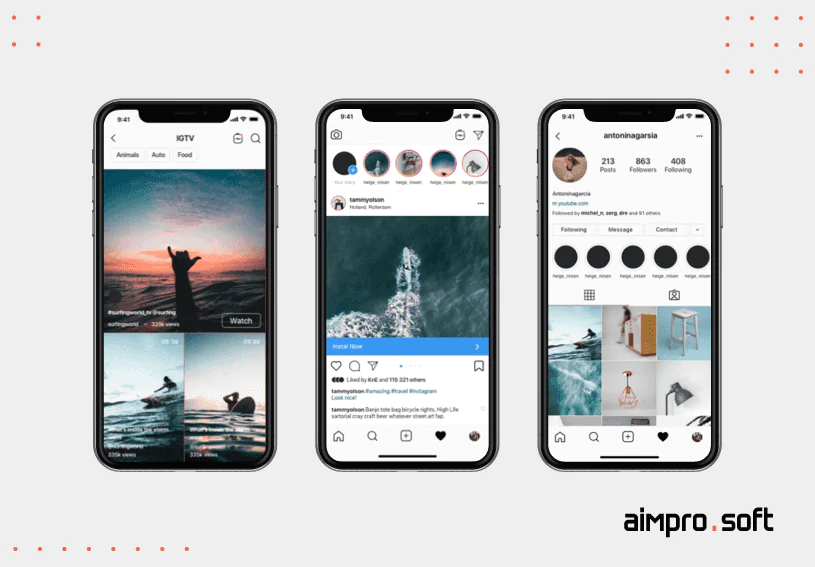
Instagram’s interface
Instagram is a popular social media platform designed for photo and video sharing. Launched in 2010, it allows users to upload content, apply filters, and share it on their profiles or through direct messages.
Key features: Photo and video sharing, stories, direct messaging, explore feed
Business model: Instagram primarily operates on an advertising-based business model. It generates revenue through sponsored posts, allowing businesses and influencers to promote their content to a targeted audience.
Developing an app like Instagram can range from $80,000 to $150,000. It’s worth noting that in 2020, Instagram generated $20 billion in revenue for its creators.
Uber
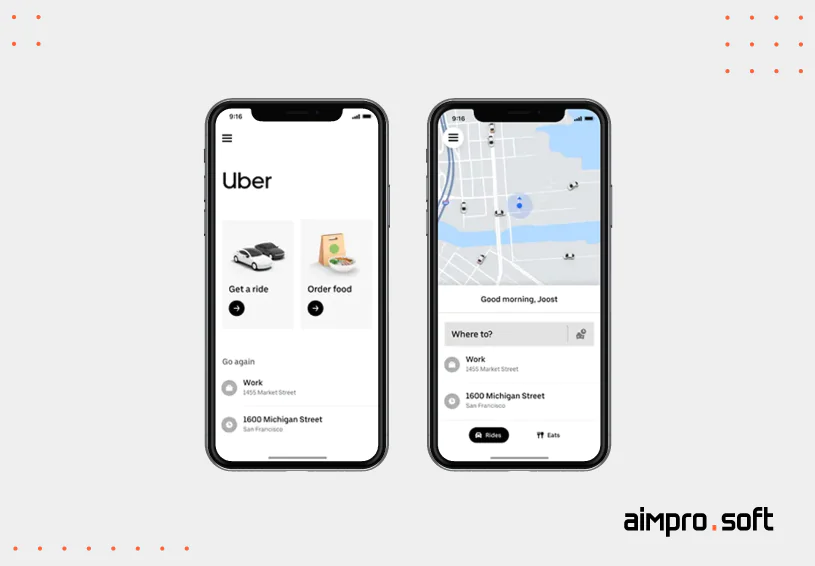
Uber’s interface
Uber is a leading ride-hailing and transportation service app founded in 2009. Users can book rides, track the location of drivers in real-time, estimate fares, and make cashless transactions.
Key features: Ride booking, real-time tracking, fare estimation, payment integration, driver and user ratings
Business model: Uber utilizes a multi-sided platform business model. It connects drivers and passengers, facilitating cost-effective transportation. Uber makes money by taking a percentage of the fare from drivers and, in some cases, charging passengers service fees.
The development cost for an app like Uber varies but is typically substantial due to the complexity of features. It can range from $90,000 to $120,000. Uber revealed a total of 7.6 billion trips, $31.9 billion in revenue, and a $9.1 billion net loss in its annual earnings report for 2022.
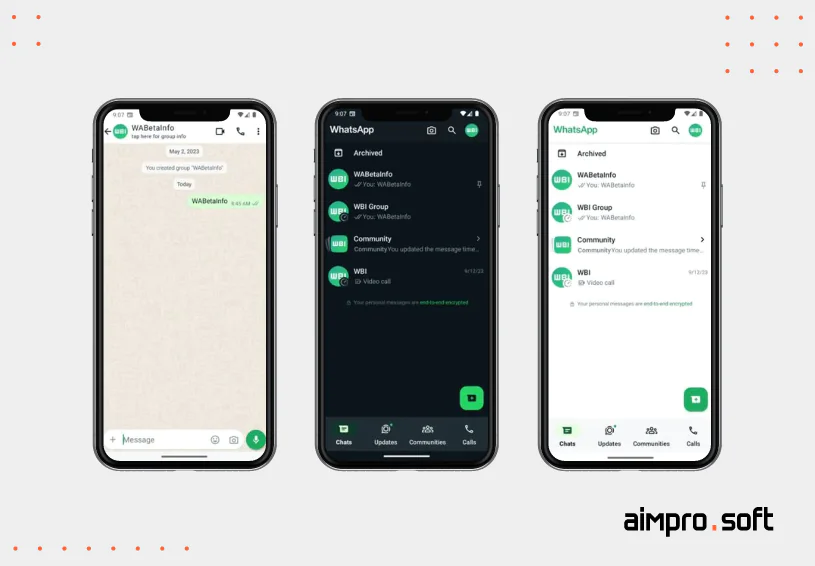
WhatsApp’s interface
WhatsApp, established in 2009, is a widely used messaging app known for its simplicity and end-to-end encryption. It lets users send text messages, make voice and video calls, and share status updates.
Key features: Messaging, voice and video calls, status updates, group chats, document sharing
Business model: WhatsApp initially adopted a subscription-based model, charging users a nominal annual fee. However, after being acquired by Facebook, WhatsApp shifted its revenue strategy. It introduced the WhatsApp Business API, allowing businesses to engage with customers through the platform and, in turn, charging businesses for certain services.
Creation of a messaging app like WhatsApp may cost between $70,000 and $90,000. WhatsApp made $8.7 billion in revenue in 2021.
Tinder
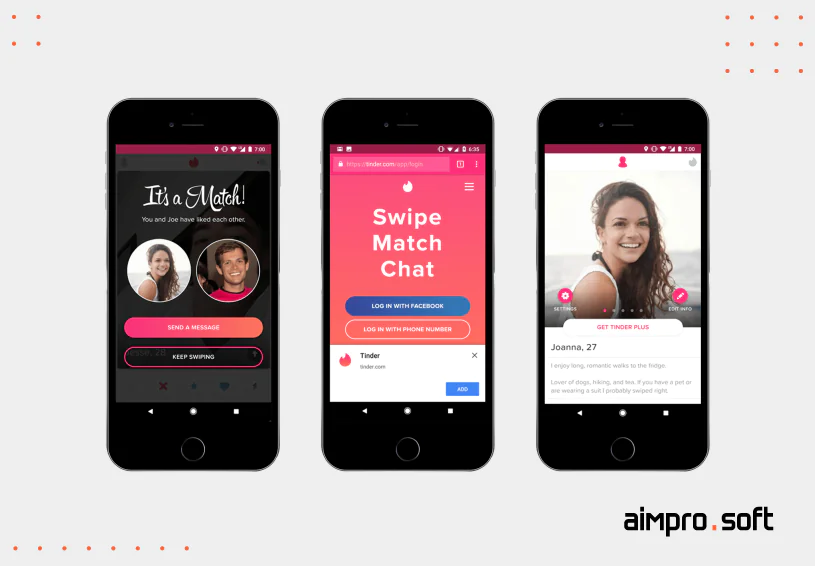
Tinder interface
Tinder, launched in 2012, is a groundbreaking online dating app. Users create profiles with photos and biographies and swipe right to like or left to skip a potential conversation partner. If two users mutually like each other, it results in a match, allowing them to chat in the app.
Key features: Profile setup, swiping, matching, chatting, premium features
Business model: Tinder operates on a freemium model. While the app is free to use, it offers premium subscription services known as Tinder Plus and Tinder Gold. These premium services provide users with additional features such as unlimited swipes, enhanced visibility, and the ability to rewind accidental swipes.
Application prices like Tinder can range from $50,000 to $70,000. Tinder has already brought its creators more than $4.8 billion over the years on the market.
Considering the examples of popular applications described above, there is only one conclusion: these applications were worth all the investments, as they bring their creators huge profits till today.
How to return your investments: choosing a business model
Taking into account the factors affecting app development’s price, it’s worth thinking about how your app will generate revenue in the future. Let’s look at popular business models that can help monetize mobile apps effectively.
Subscription-based model
This model involves charging users a recurring fee, such as monthly or yearly, to access premium features, content, or services in an app. This model is ideal for apps that offer consistent value, constant updates, and exclusive content for which users are willing to pay a subscription fee.
Pay-per-download (paid apps)
In this simple model, users make a one-time upfront payment to download and access the app’s full functionality.
The model is suitable for apps that provide immediate, tangible value and where users are willing to pay a one-time fee for full access.
In-app advertising
This model involves displaying adverts within the app. Advertisers pay for visibility, and app owners earn revenue from impressions (views) or clicks on the ad. The model is adequate for apps with a large user base, high levels of engagement, and the potential to attract advertisers interested in targeting a specific audience.
Freemium model
Apps operating under the freemium model offer a free basic version with limited features. Users can upgrade to a new version by paying for premium features, additional content, or no ads. Suitable for applications aimed at attracting a broad user base with a free version and attracting a portion of users to upgrade for more functionality.
Choosing a suitable business model for your mobile app is a critical decision that can significantly impact its success and enable a continuous revenue stream. Here are some general tips to help you choose the right business model:
1. Understand your app’s value proposition
Start by clearly defining the value of your app and the problem it solves for users. Understand what makes your app unique and why users want to engage.
2. Know your target audience
Identify your target audience’s preferences, needs, and behaviors. Consider factors such as demographics, psychographics, and geographic location.
3. Study your competitors
Study the competitors in your niche. Analyze their business models to understand what works and what doesn’t. Identify weaknesses and opportunities for differentiation.
4. Expected revenue
Set realistic revenue goals for your app. Think about how much you need to cover development and ongoing maintenance costs to make a profit.
5. User engagement
Evaluate how users will interact with your app. Some business models are based on attracting many users, while others focus on monetizing a narrower and more engaged audience.
As the mobile app market evolves, you need to keep an eye on new trends and user behavior to achieve sustained success. Understanding business models will help you navigate the intricacies of app monetization and choose a path that ensures both user satisfaction and financial sustainability.
Conclusion
From the app’s complexity to the platform where you will deploy it, we have gone the whole way by studying factors affecting the cost of mobile app development. All of them are important and should be considered to assess your business opportunities properly and identify ways for wise resource allocation. We hope this article gives you a clear understanding of what awaits you in developing your product and how to calculate your future investment property. For the development of a cost-effective and profitable project, you can always turn to us, and we will find a solution for any budget.
FAQ
What’s the typical expense for mobile app development?
The cost of mobile app development depends on complexity and functionality. Small applications can cost from $10,000, medium applications – from $40,000, complex applications – from $75,000, and more. It is important to note that these figures are approximate; to get an accurate cost estimate, it is recommended to provide the selected development team or agency with a detailed project description.
Which factors influence the cost of mobile app development?
Several factors influence the cost of development, including the scale of the app, its complexity, functionality, development approach, and geographical location. In addition, the choice of platform (iOS, Android, or both), the subtleties of user interface design, and the need for integration with external systems or APIs can affect the overall cost.
What’s the timeframe for app development?
The timeframe for app development varies based on complexity. Simple apps take a few weeks, while medium to complex apps can range from a few months to a year or more. Factors like design, testing, and deployment contribute to the overall time frame. It’s essential to consider the intricacies of user interface (UI) and user experience (UX) design, the extent of testing required for a seamless user experience, and the specific features that enhance app functionality.




